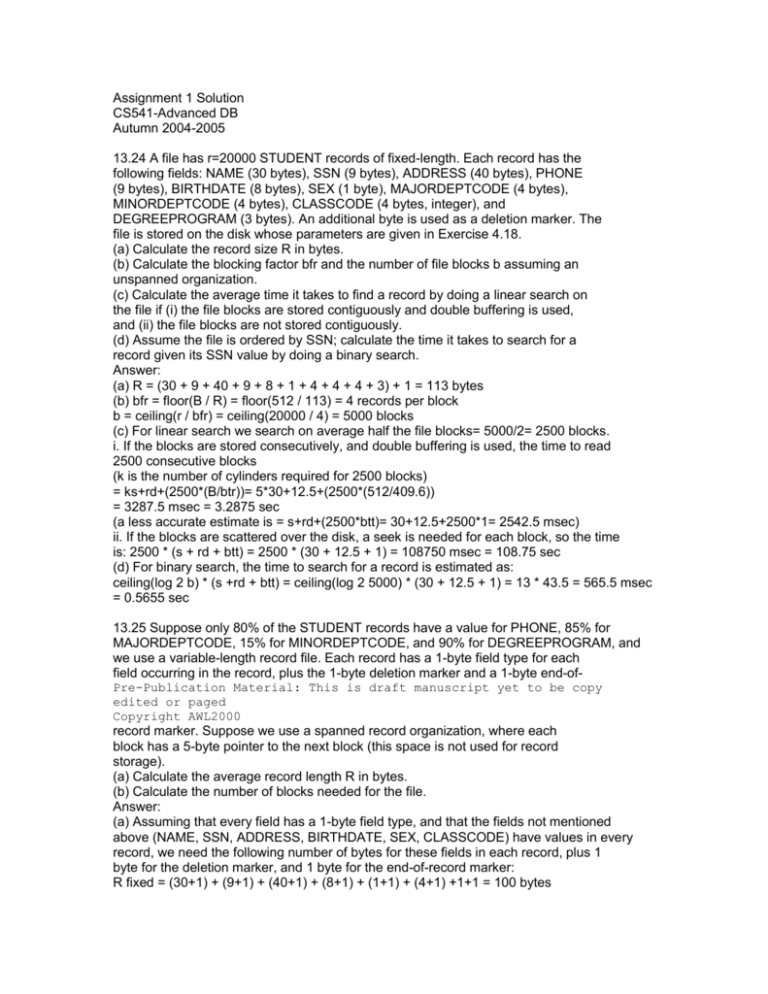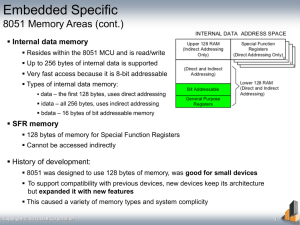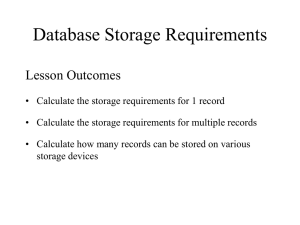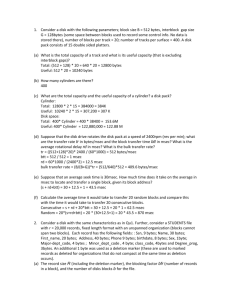Assignment 1 Solution
advertisement

Assignment 1 Solution CS541-Advanced DB Autumn 2004-2005 13.24 A file has r=20000 STUDENT records of fixed-length. Each record has the following fields: NAME (30 bytes), SSN (9 bytes), ADDRESS (40 bytes), PHONE (9 bytes), BIRTHDATE (8 bytes), SEX (1 byte), MAJORDEPTCODE (4 bytes), MINORDEPTCODE (4 bytes), CLASSCODE (4 bytes, integer), and DEGREEPROGRAM (3 bytes). An additional byte is used as a deletion marker. The file is stored on the disk whose parameters are given in Exercise 4.18. (a) Calculate the record size R in bytes. (b) Calculate the blocking factor bfr and the number of file blocks b assuming an unspanned organization. (c) Calculate the average time it takes to find a record by doing a linear search on the file if (i) the file blocks are stored contiguously and double buffering is used, and (ii) the file blocks are not stored contiguously. (d) Assume the file is ordered by SSN; calculate the time it takes to search for a record given its SSN value by doing a binary search. Answer: (a) R = (30 + 9 + 40 + 9 + 8 + 1 + 4 + 4 + 4 + 3) + 1 = 113 bytes (b) bfr = floor(B / R) = floor(512 / 113) = 4 records per block b = ceiling(r / bfr) = ceiling(20000 / 4) = 5000 blocks (c) For linear search we search on average half the file blocks= 5000/2= 2500 blocks. i. If the blocks are stored consecutively, and double buffering is used, the time to read 2500 consecutive blocks (k is the number of cylinders required for 2500 blocks) = ks+rd+(2500*(B/btr))= 5*30+12.5+(2500*(512/409.6)) = 3287.5 msec = 3.2875 sec (a less accurate estimate is = s+rd+(2500*btt)= 30+12.5+2500*1= 2542.5 msec) ii. If the blocks are scattered over the disk, a seek is needed for each block, so the time is: 2500 * (s + rd + btt) = 2500 * (30 + 12.5 + 1) = 108750 msec = 108.75 sec (d) For binary search, the time to search for a record is estimated as: ceiling(log 2 b) * (s +rd + btt) = ceiling(log 2 5000) * (30 + 12.5 + 1) = 13 * 43.5 = 565.5 msec = 0.5655 sec 13.25 Suppose only 80% of the STUDENT records have a value for PHONE, 85% for MAJORDEPTCODE, 15% for MINORDEPTCODE, and 90% for DEGREEPROGRAM, and we use a variable-length record file. Each record has a 1-byte field type for each field occurring in the record, plus the 1-byte deletion marker and a 1-byte end-ofPre-Publication Material: This is draft manuscript yet to be copy edited or paged Copyright AWL2000 record marker. Suppose we use a spanned record organization, where each block has a 5-byte pointer to the next block (this space is not used for record storage). (a) Calculate the average record length R in bytes. (b) Calculate the number of blocks needed for the file. Answer: (a) Assuming that every field has a 1-byte field type, and that the fields not mentioned above (NAME, SSN, ADDRESS, BIRTHDATE, SEX, CLASSCODE) have values in every record, we need the following number of bytes for these fields in each record, plus 1 byte for the deletion marker, and 1 byte for the end-of-record marker: R fixed = (30+1) + (9+1) + (40+1) + (8+1) + (1+1) + (4+1) +1+1 = 100 bytes For the fields (PHONE, MAJORDEPTCODE, MINORDEPTCODE DEGREEPROGRAM), the average number of bytes per record is: R variable = ((9+1)*0.8)+((4+1)*0.85)+((4+1)*0.15)+((3+1)*0.9) = 8+4.25+0.75+3.6= 16.6 bytes The average record size R = R fixed + R variable = 100 + 16.6 = 116.6 bytes The total bytes needed for the whole file = r * R = 20000 * 116.6 = 2332000 bytes (b) Using a spanned record organization with a 5-byte pointer at the end of each block, the bytes available in each block are (B-5) = (512 - 5) = 507 bytes. The number of blocks needed for the file are: b = ceiling((r * R) / (B - 5)) = ceiling(2332000 / 507) = 4600 blocks 13.28 Cancelled.







